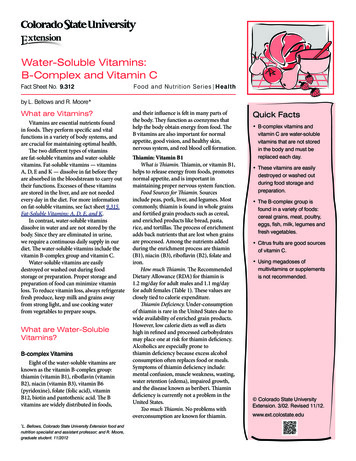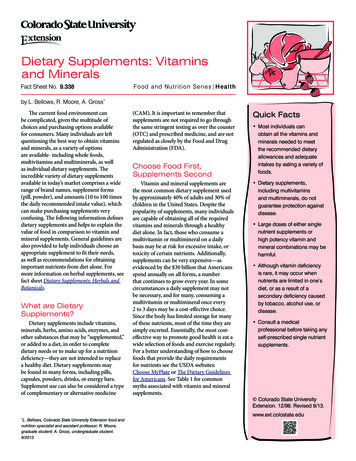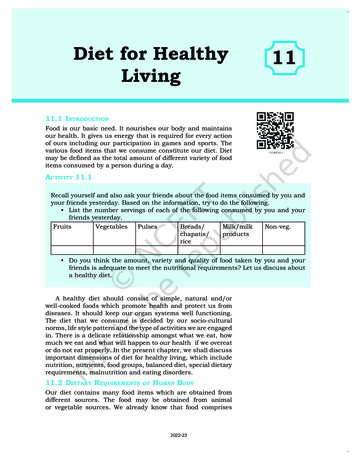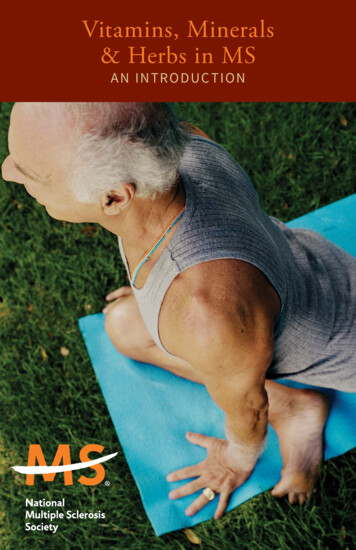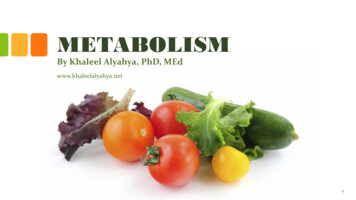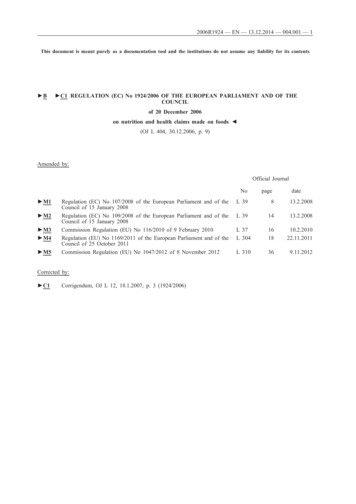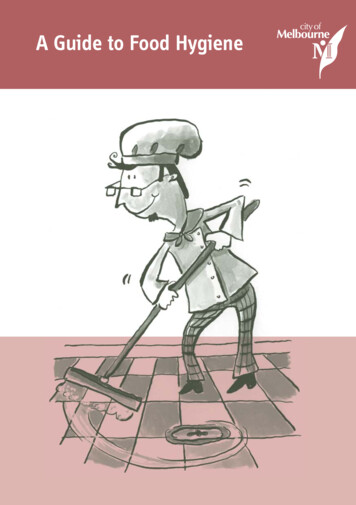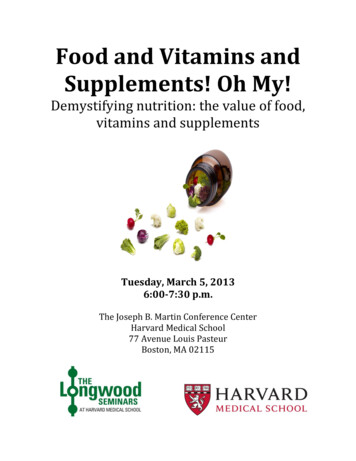
Transcription
Food and Vitamins andSupplements! Oh My!Demystifying nutrition: the value of food,vitamins and supplementsTuesday, March 5, 20136:00-7:30 p.m.The Joseph B. Martin Conference CenterHarvard Medical School77 Avenue Louis PasteurBoston, MA 02115
Food and Vitamins and Supplements! Oh My!Demystifying nutrition: the value of food, vitamins and supplementsModeratorWalter Willett, DrPH, MDChair, Department of Nutrition,Harvard School of Public HealthFredrick Stare Professor of Epidemiology and Nutrition,Harvard School of Public HealthProfessor of Medicine,Harvard Medical SchoolSpeakersHoward Sesso, ScD, MPH, FAHAAssociate Professor of Medicine,Harvard Medical SchoolAssociate Epidemiologist,Brigham and Women's HospitalEric Rimm, ScDAssociate Professor of Medicine,Harvard Medical SchoolBrigham and Women’s HospitalAssociate Professor of Epidemiology and Nutritionand Director, Program in CardiovascularEpidemiologyHarvard School of Public Health
About the SpeakersWalter Willett, DrPH, MDDr. Walter Willett is Professor of Epidemiology and Nutrition and Chairman of theDepartment of Nutrition at Harvard School of Public Health and Professor of Medicine atHarvard Medical School. Dr. Willett, an American, was born in Hart, Michigan and grew up inMadison, Wisconsin, studied food science at Michigan State University, and graduated fromthe University of Michigan Medical School before obtaining a Doctorate in Public Health fromHarvard School of Public Health. Dr. Willett has focused much of his work over the last 30years on the development of methods, using both questionnaire and biochemical approaches,to study the effects of diet on the occurrence of major diseases. He has applied these methodsstarting in 1980 in the Nurses’ Health Studies I and II and the Health Professionals Follow-upStudy. Together, these cohorts that include nearly 300,000 men and women with repeateddietary assessments are providing the most detailed information on the long-term healthconsequences of food choices.Dr. Willett has published over 1,500 articles, primarily on lifestyle risk factors for heartdisease and cancer, and has written the textbook, Nutritional Epidemiology, published byOxford University Press. He also has three books book for the general public, Eat, Drink andBe Healthy: The Harvard Medical School Guide to Healthy Eating, which has appeared onmost major bestseller lists, Eat, Drink, and Weigh Less, co-authored with Mollie Katzen, andmost recently, The Fertility Diet, co-authored with Jorge Chavarro and Pat Skerrett. Dr.Willett is the most cited nutritionist internationally, and is among the five most cited personsin all fields of clinical science. He is a member of the Institute of Medicine of the NationalAcademy of Sciences and the recipient of many national and international awards for hisresearch.Howard Sesso, ScD, MPH, FAHADr. Howard D. Sesso is an Associate Epidemiologist at the Divisions of Preventive Medicineand Aging at Brigham and Women’s Hospital (BWH), and an Associate Professor ofMedicine at Harvard Medical School. He received his BA in Human Biology from StanfordUniversity, an MPH in Epidemiology from The George Washington University, and a ScD inEpidemiology from the Harvard School of Public Health. Dr. Sesso specializes in theepidemiology and prevention of cardiovascular disease (CVD), focusing on the roles ofhypertension, physical activity, obesity, and dietary factors such as antioxidant vitamins,lycopene, flavonoids, and alcohol, as well as the role of novel biomarkers that underliethese associations. He is also interested in the role of diet and lifestyle factors in theprevention of cancer. Dr. Sesso is Director of Nutrition Research and Co-Director ofHypertension Research at the Division of Preventive Medicine. Dr. Sesso is also interestedin the design, methodology, and conduct of epidemiologic studies and randomized clinicaltrials. He leads the Physicians’ Health Study II, a recently completed randomized trial that
tested whether common supplemental doses of vitamin E, vitamin C, and a multivitaminhave any effect on cardiovascular disease, cancer, and other chronic diseases in 14,641 meninitially aged 50 years. Dr. Sesso is also currently testing the effects of vitamin D and fishoil supplements on ambulatory blood pressure and the risk of developing hypertension inan ancillary study from the large-scale VITamin D and OmegA-3 TriaL (VITAL) trial.Eric Rimm, ScDEric Rimm is an Associate Professor of Epidemiology and Nutrition at the Harvard School ofPublic Health and Harvard Medical School and is the Director of the Program inCardiovascular Epidemiology. He has an active research program in the study of diet,lifestyle characteristics, and cardiovascular disease and has published more than 400 peerreviewed publications during his 18 years on the faculty at Harvard. He has previouslyserved on the Institute of Medicine’s Dietary Reference Intakes for macronutrients andrecently served as one of 13 members on the scientific advisory committee for the 2010 U.S.Dietary Guidelines for Americans. This year he was awarded the 2012 American Societyfor Nutrition General Mills Institute of Health and Nutrition Innovation Award.Dr. Rimm is an international speaker on diet and health and has given talks to academicgroups, industry, and public health organizations across the globe. For the last decade hehas spoken at the Culinary Institute of America’s Worlds of Healthy flavors to industrygroups and also at the Healthy Kitchens, Healthy Lives to medical health professionalsDr. Rimm is an associate editor for the American Journal of Clinical Nutrition and theAmerican Journal of Epidemiology.
Demystifying nutrition: the value of food, vitamins and supplementsLongwood Seminars, March 5, 2013The following content is provided by Harvard Health PublicationsDo multivitamins protect you fromdisease?Multivitamins may slightly reduce the risk of cancer but don’t prevent heart disease. Keepthe focus on diet, not supplements.Up to half of all adults in the United States may already take a multivitamin. Most probably expect it to makethem feel better and prevent common illnesses, even though the evidence has always been a little sketchy. Isthe daily multivitamin habit truly healthful—or just wishful thinking?The Harvard-led Physicians Health Study II (PHS II) recently found that taking a multivitamin slightly lowersthe risk of being diagnosed with cancer. But if you take a multivitamin already or plan to, don’t let it distractyou from eating a varied and nutritious diet. “The studies of taking vitamins to prevent disease have beenlargely disappointing,” says Dr. William Kormos, editor in chief of Harvard Men’s Health Watch and a primarycare physician at Harvard-affiliated Massachusetts General Hospital. “It does not appear that a multivitamincan replace a healthy diet high in fruits and vegetables.”Multivitamins lower cancer risk by 8%Study II, involving about 15,000 doctors, looked at the effect ofmultivitamins on disease risk. Here are the results per 1,000 men.Result: 13 fewer men were diagnosed with cancer because they took amultivitamin—an 8% reduction in cancer diagnosis, but not in death.
Demystifying nutrition: the value of food, vitamins and supplementsLongwood Seminars, March 5, 2013The following content is provided by Harvard Health PublicationsPutting multivitamins to the testMany studies have looked at the effect of vitamin and mineral supplements on disease, but the evidence hasnever been convincing. So most experts have hedged on whether to recommend multivitamins for everyone.The PHS II study involved nearly 15,000 physicians. Half were chosen at random to take a daily multivitamin;the others received a placebo pill containing no vitamins or minerals. The men took their pills for an averageof just over 11 years. At the end of the study, researchers determined who developed cancer or heart diseaseand how many died from those diseases, which account for roughly half of all U.S. deaths annually.The PHS II was the first study to test a standard multivitamin for the prevention of chronic disease. “All theother studies were done with a single supplement, or combinations of two or three, usually at higher levelsthan you could get from your diet,” explains Dr. J. Michael Gaziano, a cardiologist at Harvard-affiliatedBrigham and Women’s Hospital and VA Boston Healthcare, and one of the leaders of the PHS II study.The cardiovascular disease portion of the study focused on whether taking a multivitamin reduced the risk ofheart attacks, strokes, and death from cardiovascular disease. There was no effect, weakening the case fortaking a multivitamin “just in case” to prevent heart disease.Cancer preventionHowever, PHS II did find that taking a supplement reduced the risk of being diagnosed with a new cancer by8%. The trial found indications that the multivitamin might reduce death from cancer, too, but the effect wasweak and could have been due to chance.If you don’t take a multivitamin now, should you do so based on the PHS II findings? Dr. Gaziano thinks it’s areasonable choice. The cost of multivitamins is negligible for most people—less than a dime a day if you buyno-name brands in bulk at a large discount chain. And PHS II found no reason to believe that taking amultivitamin is dangerous. Moreover, “taking a multivitamin to prevent deficiency is not a bad idea,” Dr.Gaziano says. “Many Americans don’t get what they need.”As for cancer prevention, he argues, the supplement offers a new option to an aging population at high riskof developing cancer at some point in their lives. “Until now, the only things proven to prevent cancer werestopping smoking and never starting,” Dr. Gaziano says. “Now we know that multivitamins provide a modestbenefit.”Benefits for all?But it is difficult to know from the PHS II study what ultimate benefit a multivitamin would provide for thegeneral population. Compared with most people, the doctors in the study ate better diets, were morephysically active, and engaged in fewer unhealthy activities. Less than 4% were smokers, and 60% exercisedat least once a week. In contrast, American men on average are overweight, don’t exercise as much as theyshould, and take in too much fat and sodium. Would a multivitamin help them, too?
Demystifying nutrition: the value of food, vitamins and supplementsLongwood Seminars, March 5, 2013The following content is provided by Harvard Health PublicationsOne could argue that if something helps healthy people a little, it should help less healthy people more. Butit’s also possible that the modest anti-cancer benefit of taking multivitamins wouldn’t make much of a dent,compared with the effect of less healthy lifestyles in the general population. Don’t expect to see a massivenew clinical trial to answer that question anytime soon.Dr. Gaziano takes the optimistic view: “If you consider even a modest reduction in risk for a disease ascommon as cancer in the population at large, it’s not trivial numbers that you’re talking about.”Vitamin and mineral supplements:Too much of a good thing can make you sickWhen it comes to vitamins and minerals, some people subscribe to the notion that if a little isgood, then more is better. But nutrients can be harmful when taken in amounts above what’sconsidered beneficial.Determining the right amount is tricky, however. Each nutrient has a range that starts with theminimum daily intake level necessary to meet the needs of most healthy people, called theRecommended Dietary Allowance (RDA). The top of the range is given as the tolerable upperintake level (UL) of the nutrient. The amount right for you must be based on your needs, so talkto your doctor before you start taking new vitamin and mineral supplements.“Exceeding the RDA is not a medical problem essentially until the UL is reached, and then it canbecome harmful,” explains Dr. Bruce Bistrian, chief of clinical nutrition at Beth Israel DeaconessMedical Center and professor of medicine at Harvard Medical School.A multivitamin for you?Still, it’s important not to overplay the benefit that PHS II found for preventing cancer. “The effect in thisstudy is relatively small,” Dr. Kormos says. Rather than relying on supplements, it’s a better to obtainnutrients from food, which contains a variety of healthful ingredients.Fruits and vegetables contain many biologically active ingredients that may help to prevent cancer in waysthat vitamins and minerals alone do not. “A healthy diet still seems superior to taking a multivitamin, and ifyou already eat a healthy diet, there may be less overall benefit from taking the extra vitamins,” Dr. Kormossays. You’ll hear similar advice from the American Cancer Society and the American Heart Association.In considering the pros and cons of multivitamins, stop for a moment and ask what you expect to gain andwhy you think you need a supplement to begin with. “If people ask me if they should take a multivitamin, Iusually ask, Why do you think you need one?” Dr. Kormos says. “They say, well, I don’t eat this, I don’t eatthat. But a multivitamin is not going to replace the things missing from your diet. Whatever money you arespending on your multivitamin, it’s probably better to spend it at the farmer’s market or the grocery store onhealthy foods.”
Demystifying nutrition: the value of food, vitamins and supplementsLongwood Seminars, March 5, 2013The following content is provided by Harvard Health PublicationsTo learn more This information is prepared by the editors of the Harvard Health Publications division of Harvard MedicalSchool. It originally appeared in the February 2012 issue of the Harvard Men’s Health Watch available fromhttp://health.harvard.edu/mens.12 Tips for healthier eatingIt’s not about individual nutrients anymore.For much of the 20th century, nutrition research focused largely on the health risks and benefits of singlenutrients. The findings translated into public health messages telling us to reduce fat; limit cholesterol;increase fiber; get more calcium; take vitamins E, C, and D; and so on. But as scientists learn more, they’refinding that the health effects of food likely derive from the synergistic interactions of nutrients and othercompounds within and among the foods we eat. This has led to a shift from nutrient-basedrecommendations toward guidelines based on foods and eating patterns.There’s no single healthy diet. Many eating patterns sustain good health. What they have in common is lotsof fruits, vegetables, and whole grains, along with healthy sources of protein and fats. Consistently eatingfoods like these will help lower your risk for conditions such as heart disease, stroke, diabetes, and certainforms of cancer. If you’d like to make this largely plant-based approach to eating one of your good-healthgoals for 2012, here’s how to get started.1. Build a better plate. In the fall of 2011, nutrition experts at the Harvard School of Public Health andcolleagues at Harvard Health Publications unveiled the Healthy Eating Plate (see below), a visual guide tohealthful eating that improves on the government’s “MyPlate.”Both guides are meant to simplify the task of planning healthy meals. The Healthy Eating Plate is made up ofone-half vegetables and fruits, one-quarter whole grains, and one-quarter healthy protein. “Whole” and“healthy” are important words here. Refined grains (think white breads, pastas, and rice) have less fiber andfewer nutrients than whole grains, such as whole-wheat bread and brown rice (see No. 4). Healthy proteinsinclude fish, poultry, beans, and nuts — but not red meats or processed meats. Many studies have shownthat red meats and especially processed meats are linked with colorectal cancer — and that you can loweryour risk for heart disease by replacing either type of meat with healthier protein sources. So eat red meatssparingly (selecting the leanest cuts), and avoid processed meats altogether. Hint: To learn more about theHealthy Eating Plate, go to www.health.harvard.edu/plate.
Demystifying nutrition: the value of food, vitamins and supplementsLongwood Seminars, March 5, 2013The following content is provided by Harvard Health Publications2. Pile on the vegetables and fruit. Vegetables and fruits are high in fiber and contain many vitamins andminerals as well as hundreds of beneficial plant chemicals (phytochemicals) that you can’t get in supplements(see No. 8). Diets rich in vegetables and fruit can benefit the heart by lowering blood pressure, cholesterollevels, and inflammation and improving insulin resistance and blood vessel function. In long-termobservational studies, people who eat more fruits and vegetables have a lower risk of heart disease,diabetes, and weight gain, and those who eat more fruit also have a lower risk of stroke. Hint: Fresh fruitsand vegetables are great, but don’t avoid the frozen kind (or dried fruit or canned fruits and vegetablesminus the heavy syrup or salt) when they’re more convenient.3. Go for the good fats. At one time, we were told to eat less fat, but now we know that it’s mainly the typeof fat that counts. The most beneficial sources are plants and fish. You can help lower “bad” LDL cholesterolby eating mostly polyunsaturated fats (including vegetable oils and omega-3 fatty acids, found in fish, seedsand nuts, and canola oil) and monounsaturated fats (in avocados and many plant-based oils, such as olive oiland canola oil). Saturated fats (found mostly in dairy and meat products) and trans fats (hydrogenated fatfound in many fried and baked goods) boost LDL cholesterol and triglycerides, increasing your risk of heartdisease. Worse still, trans fats reduce your “good” HDL cholesterol. Hint: As long as you replace bad fats withgood ones, you can get up to 35% of your calories from fat.4. Replace refined grains and potatoes with whole grains. Whole grains retain the bran and germ of thenatural grain, providing healthful fiber, vitamins and minerals, antioxidants, and phytochemicals. Many ofthese substances are removed from refined grains, such as white bread and white rice, and are barelypresent in starches such as potatoes. Starches and refined carbohydrates are digested quickly, causing surgesin insulin and blood sugar, boosting triglycerides, and lowering HDL cholesterol. These changes increase therisk of heart disease and diabetes. The rapid rise and fall of blood sugar and insulin can also make you
Demystifying nutrition: the value of food, vitamins and supplementsLongwood Seminars, March 5, 2013The following content is provided by Harvard Health Publicationshungry, raising the risk of weight gain. Potatoes aren’t all bad; they’re a good source of vitamin C, potassium,and fiber. But eat them only occasionally, in small amounts, and with the skins on (that’s where the fiber is).Hint: Be adventurous. In addition to whole wheat and brown rice, try quinoa, millet, farro, and amaranth.Some of these whole grains can be cooked like hot cereal or rice, and some are ground into flour for baking.“Carb-check” your breads and cerealsSome carbohydrates are good for health and others aren’t. The worst carbohydrate sources usehighly refined grains and sugars. The best have whole or minimally processed grains. One way toidentify a good carb source is to divide the number of grams of carbohydrate per serving by thenumber of grams of fiber. Aim for less than 10 for breads and under five for cereals.5. Eliminate liquid sugars. Sugar-sweetened beverages — non-diet sodas, sugary fruit drinks, iced teas withadded sugar, and sports drinks — provide calories and little else. There’s good evidence that these drinks canraise the threshold for satiety (feeling full), thereby increasing the amount you eat and promoting weightgain. A 2011 Harvard study found that sugar-sweetened beverages were one of the dietary components moststrongly linked to long-term weight gain among healthy women and men. What about 100% fruit juice withno added sugar? Even all-natural fruit juice has a lot of calories. The Healthy Eating Plate guidelines suggestyou drink no more than one small glass a day (say, 4 to 6 ounces). Hint: Add carbonated water to your “onesmall glass” for full-glass satisfaction.6. Drink enough water. Many foods contain water, so you may get enough every day without making aspecial effort. But it can be helpful to drink water (or another no-calorie liquid, such as black tea, coffee, orcarbonated water) with meals or as an alternative to snacking. A reasonable goal is 4 to 6 cups of water aday. Hint: As you add whole grains to your diet, water helps move the fiber smoothly through your digestivetract, reducing the chances of constipation.7. Learn to like less sodium. The body needs sodium for proper muscle and nerve function and fluid balance,but excessive amounts can increase blood pressure and the risk of heart disease and stroke. The dangers of asalty diet (salt is 40% sodium) are greatest in people over age 50, African Americans, and women. You’ll doyourself a favor if you wean your taste buds from a yen for salt. Limit your daily sodium intake to 2,300milligrams (mg) — the amount in one teaspoonful of salt. If you have high blood pressure or are at risk for it,get no more than 1,500 mg per day. Hint: Most of the sodium Americans consume comes from processedand restaurant foods. Instead, choose fresh, unprocessed foods, and prepare them yourself. Read thenutrition content on labels and make sure that the per-serving sodium content is less than the calories perserving.8. Rethink supplements. It’s best to get your vitamins and minerals from food rather than supplements, butthis can be hard, especially if you’re cutting calories or your energy needs are low. We showed how to meetalmost all your nutrient needs through food alone, even if you’re consuming 1,500 calories or less per day(see www.health.harvard.edu/vits). The key is choosing nutrient-dense foods, such as leafy greens, low-fatyogurt, dried beans, whole grains, and salmon. The only problem is vitamin D. Here a supplement is probablya good idea, because it’s difficult to get the recommended daily intake (600 to 800 IU) through foods. Hint:
Demystifying nutrition: the value of food, vitamins and supplementsLongwood Seminars, March 5, 2013The following content is provided by Harvard Health PublicationsYou can get enough calcium on a 1,500-calorie-a-day diet by eating low-fat dairy products and nondairyfoods such as canned salmon, tofu, sesame seeds, dark leafy greens like collards and kale, and legumes suchas pinto and kidney beans.9. Dine mindfully. Taking time to savor your food not only makes eating more enjoyable, it can also helpcontrol your appetite. Your sense of fullness and satisfaction depends on hormonal signals from yourdigestive tract. If you eat too quickly, your brain may not receive the signals that say you’re full. Try puttingdown your fork between bites and chewing more slowly. Tune in to your food’s aroma, taste, and texture,and stop eating when you feel full. Some small studies suggest that this approach may help some peoplemake healthier food choices. Hint: To start, try taking one mindful bite at the beginning of each meal — asort of eating speed bump.10. Keep alcohol under control. Many studies link moderate alcohol consumption (for women, no more thanone drink per day) to heart benefits, including a reduced risk of heart attack, increases in “good” HDLcholesterol, and reduced risk for type 2 diabetes, gallstones, and dementia. One drink per day also slightlyincreases your risk for breast cancer, and the risk increases steadily the more alcohol you consume. There areplenty of other ways to get heart benefits, so if you don’t like alcohol, don’t have it. But if you enjoy anoccasional cocktail or a glass of wine with dinner, you need to weigh the risks and benefits in light of yourown situation. Hint: If you find that one drink often turns into two or more, consider quitting or getting helpto cut back. For help, go to http://rethinkingdrinking.niaaa.nih.gov.)11. Eat breakfast. It’s easy to skip breakfast when you’re in a rush, aren’t hungry, or want to cut calories. Buta healthy morning meal makes for smaller rises in blood sugar and insulin throughout the day, which canlower your risk of overeating and impulse snacking. (Eating breakfast every day is one characteristic commonto participants in the National Weight Control Registry, who’ve lost at least 30 pounds and kept the weightoff longer than a year.) Hint: A healthy, balanced breakfast is moderate in size and includes healthy protein,whole-grain carbohydrates, and fruit — for example, an egg, whole-wheat toast, and strawberries. If you likecereal, have whole-grain cereal with fruit and low-fat yogurt or milk.12. Plan for a snack attack. Snacking isn’t an essential part of a healthy eating plan, but try telling that to arumbling stomach at midafternoon. A healthy snack can boost energy levels by stabilizing blood sugar whilegiving you an added dose of healthful nutrients. But unplanned, impulsive snacking often takes the form ofcookies, chips, or candy bars. So prepare healthy snacks ahead of time, and keep them handy at home or inyour office. Limit calories to about 100 to 150 per snack. Good choices include a small bunch of grapes, abanana, or other fruit; a handful of unsalted nuts or sunflower seeds; and plain nonfat yogurt with a fewraspberries or strawberries tossed in. Hint: Before giving in to a snack attack, drink an 8-ounce glass of waterand wait 10 to 15 minutes to see if you’re still hungry.To learn more This information is prepared by the editors of the Harvard Health Publications division of Harvard MedicalSchool. It originally appeared in the January 2012 issue of the Harvard Women’s Health Watch availablefrom http://www.health.harvard.edu/newsletters/womens.
Demystifying nutrition: the value of food, vitamins and supplementsLongwood Seminars, March 5, 2013The following content is provided by Harvard Health PublicationsVitamin D and calcium supplements: takethem or leave themHow to follow the changing recommendations without making yourself dizzy.First we were advised to take calcium and vitamin D supplements to strengthen our bones and protectagainst fractures. Then in June, the U.S. Preventive Services Task Force recommended against low-dosecalcium and vitamin D supplements, citing little evidence that they actually prevent fractures and noting thatthey can increase the risk of kidney stones.A European study added another dose of bad news, linking calcium supplements with a greater risk for heartattacks. Then the tides shifted again, when another analysis suggested calcium and vitamin D supplementsmight help older adults live longer.So which is it? Do calcium and vitamin D supplements help—or hurt?Why you need calciumThere’s no question that your body needs calcium. It’s involved in everything from nerve signal transmissionto blood vessel health. Calcium builds and strengthens bones—a function that’s especially critical aftermenopause, when bones become more fragile and prone to fractures. Vitamin D helps the body absorbcalcium, which is why the two nutrients are often paired up in supplements.According to the Institute of Medicine (IOM), women over age 50 need 1,200 milligrams (mg) of calcium aday, and 600 to 800 international units (IU) of vitamin D a day. The issue isn’t whether you need calcium—it’show you should get it. And most, if not all, of your calcium should come from your kitchen—not yourmedicine chest.“I think calcium and vitamin D are important for bone health, but I recommend that patients get calciumfrom their diet,” explains Dr. Meryl LeBoff, director of the Skeletal Health and Osteoporosis Center and BoneDensity Unit at Brigham and Women’s Hospital and professor of medicine at Harvard Medical School.If you’re not getting enough calcium from diet alone, add a supplement—but only take as much in pill formas you need.“I tell patients to estimate the amount of calcium they are getting from their diet and then supplement it. Idon’t want them to take excess calcium,” says Dr. David Slovik, associate professor of medicine at HarvardMedical School, chief of the Endocrine and Diabetes Unit at Newton-Wellesley Hospital, and endocrinologistat Massachusetts General Hospital.
Demystifying nutrition: the value of food, vitamins and supplementsLongwood Seminars, March 5, 2013The following content is provided by Harvard Health PublicationsGetting enough nutrientsGood food sources of calcium include low-fat yogurt, 8 ounces (415 mg) calcium-fortified orange juice, 6 ounces (375 mg) sardines, canned in oil, with bones, 3 ounces (325 mg) cheddar cheese, 1.5 ounces (307 mg) nonfat milk, 8 ounces (299 mg) canned salmon with bones, 3 ounces (181 mg) tofu, soft, made with calcium sulfate, 1/2 cup (138 mg) fresh cooked kale, 1 cup (94 mg).Vitamin D is activated in sun-exposed skin, but that source can be hard to come by in the winter months,especially if you live in a northern climate. Too much unprotected sun exposure also increases your risk forskin cancers.Good food sources of vitamin D include cod liver oil, 1 tablespoon (1,360 IU) swordfish, cooked, 3 ounces (566 IU) salmon, cooked, 3 ounces (447 IU) tuna fish, 3 ounces (154 IU) vitamin D-fortified orange juice, 1 cup (137 IU) vitamin D-fortified milk, 1 cup (115-124 IU) vitamin D-fortified yogurt, 6 ounces (80 IU).Get more calcium and vitamin D from your diet, but don’t drop your supplement solely based on the latestnews story. Your bones could suffer for it. The decision to take supplements should be individualized basedon your diet, and your unique risks. “Review the specific recommendations with your doctor, because theseare important health decisions,” Dr. LeBoff advises.
Demystifying nutrition: the value of food, vitamins and supplementsLongwood Seminars, March 5, 2013T
Food and Vitamins and Supplements! Oh My! Demystifying nutrition: the value of food, vitamins and supplements Tuesday, March 5, 2013 6:00-7:30 p.m. The Joseph B. Martin Conference Center Harvar
